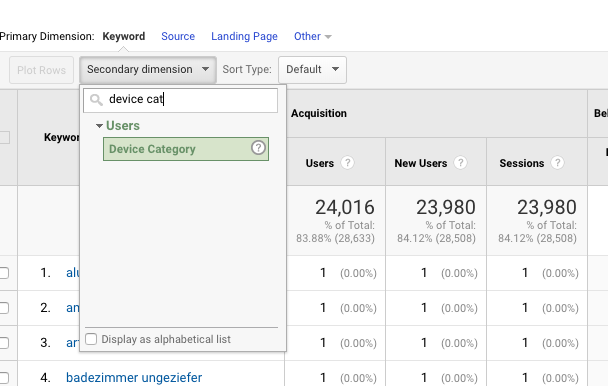Unlock Deeper Insights With Secondary Measurement in Google Analytics
With the huge area of information available in Google Analytics, the use of secondary measurements can considerably enhance your analytical abilities. These added layers of data provide a nuanced perspective that can brighten intricate details within your key metrics. By purposefully incorporating secondary measurements right into your evaluation, you can unearth important insights that could or else stay obscure. The ability to translate and divide user actions with higher accuracy opens a world of opportunities for boosting and enhancing methods performance.
Recognizing Primary Vs. Secondary Dimensions
When assessing data in Google Analytics, it is necessary to distinguish between primary and additional dimensions to gain much deeper understandings right into user behavior. Main dimensions are the main classifications through which you can watch your data, such as source/medium, touchdown, or tool web page. These dimensions give the essential structure for organizing and comprehending your information. On the other hand, additional dimensions allow you to additional explore your primary dimension data. By adding a secondary dimension, you can layer on additional details to your key measurement, enabling an extra granular evaluation. If your key dimension is the source/medium via which customers got here on your website, adding a second measurement like geographic location can disclose where those individuals are located geographically. This included layer of information can assist you recognize patterns, patterns, or anomalies that might not have appeared when checking out the main dimension alone. Leveraging both key and additional dimensions in Google Analytics is important for extensive information analysis and informed decision-making.
Utilizing Secondary Measurements Efficiently
By integrating secondary measurements together with main dimensions, marketing professionals and analysts can delve much deeper into the specifics of customer communications on their sites. Secondary measurements allow customers to section and filter primary measurement data further, supplying an extra comprehensive view of user demographics, behaviors, and communications.
Moreover, second dimensions enable customers to compare and contrast different information factors within a solitary report, helping with a more detailed analysis of individual habits patterns. By leveraging secondary measurements properly, companies can reveal hidden understandings, maximize their advertising methods, and enhance the general customer experience on their sites.
Discovering Common Additional Dimension Mixes
To further assess user habits and fads in Google Analytics, it is beneficial to check out typical mixes of second measurements. By combining different additional dimensions, marketing professionals and analysts can acquire deeper understandings right into how various variables interact and influence site efficiency. Some usual additional measurement mixes that offer beneficial insights include analyzing web traffic sources with customer locations to recognize where internet site site visitors are coming from geographically and how they located the website. Incorporating landing pages with tools can reveal which pages perform best on various devices, helping in enhancing the website for far better user experience. Additionally, taking a look at individual actions metrics with second dimensions such as demographics or interests can help in targeting details target market sectors extra effectively. By exploring these common additional dimension combinations, businesses can reveal surprise patterns, determine possibilities for renovation, and make data-driven choices to enhance their online presence.
Applying Second Dimension in Custom-made Reports
Making use of second dimensions in custom-made reports allows for a more extensive evaluation of information in Google Analytics, enhancing the depth of insights gotten. When creating custom records in Google Analytics, including second measurements can provide a much more thorough sight of how various dimensions interact with each various other. This function allows customers to dive deeper into their information and uncover important connections that might not be right away obvious.
By using second dimensions in custom-made reports, users can gain a better understanding of their site or app website traffic. For instance, combining the key dimension of "source/medium" with the second dimension of "landing page" can disclose which landing pages are here are the findings doing finest for website traffic coming from specific resources. This understanding can help marketers enhance their campaigns and enhance total conversion rates.

Enhancing Information Visualization With Secondary Dimension
When discovering data in Google Analytics custom records, including secondary measurements not only supplies an extra detailed analysis yet also improves the aesthetic representation of insights through information visualization. By including a secondary dimension to your reports, you can enhance the means information is provided, making it simpler to determine patterns, patterns, and connections within your web site's efficiency metrics.
Second dimensions can assist you section your data additionally, enabling a deeper understanding of individual habits and communications on your site. When trying to isolate particular variables that might affect your internet site's performance., this enhanced degree of granularity can be particularly beneficial.

Final Thought
Finally, leveraging second measurements in Google Analytics allows for an extra comprehensive evaluation of information, resulting in much deeper insights and more enlightened decision-making. Secondary Dimension in Google Analytics. By adding extra layers of details to main information sets, experts and online marketers can reveal hidden patterns, patterns, and correlations that give a granular view of customer actions and interactions. This boosted degree of insight makes it possible for optimization of campaigns and tailored approaches for particular target market sections, eventually enhancing performance and conversion rates
On the various other hand, secondary dimensions enable you to more dissect your main measurement data. By including a secondary dimension, you can layer on added information to your key dimension, enabling a much more granular evaluation. If your key measurement is the source/medium with which users arrived on your site, including an additional dimension like geographical place can expose where those customers are situated geographically. By including second dimensions alongside main measurements, online marketers and analysts can dive deeper right into the specifics of customer interactions on their websites. Secondary dimensions enable users to segment and filter primary dimension information additionally, offering a more in-depth sight of user habits, demographics, and interactions.
Comments on “Maximize Your Coverage with Secondary Dimension in Google Analytics”